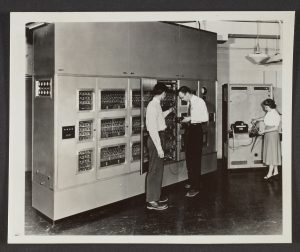Guest Post by Bethany Anderson, Archival Operations and Reference Specialist at the University of Illinois Archives, and Alicia Hopkins, graduate student in the University of Illinois School of Information Science
Documenting women in science, technology, engineering and math (STEM) has been challenging given the historically fewer numbers of women in STEM fields. Likewise, women in STEM have not been well documented by archival repositories. And similarly, archival sources about women in computing are underrepresented.
Oral history is an effective tool for filling and remediating gaps in archival holdings. Though it is sometimes viewed as a complement to paper and born-digital records, oral history is itself a unique form of archival evidence. Oral history can also be an effective form of archival evidence for underrepresented and marginalized communities and individuals, especially for women in a profession like computing, where archival documentation can be difficult to locate.
The project From Margin to Center: Reframing the History of Women in Computing and Information Technology through Oral Histories was conceptualized as a way to begin remediating information about women in the University of Illinois Archives’ own holdings for the Department of Computer Science (CS). Generously funded by the Association for Computing Machinery (ACM) History Committee, this oral history project enabled archivist Bethany Anderson to conduct interviews with women faculty and alumnae from CS and IT professionals at the U of I.
Between May 2017 and April 2018, Anderson interviewed six women at different points in their career trajectories. The result is two interviews with faculty members (Klara Nahrstedt and Tandy Warnow), two staff members (Ramona Borders and Debbie Fligor), and two graduates of CS (Wanmin Wu and Ambika Dubey). The interviews reveal insight into gender dynamics in the history of computing on campus and what the computing enterprise looks like from the unique vantage points of the interviewees.

Ramona Borders is pictured far right, ca. 1950s. From Engineering Photographs and Negatives (RS 11/1/12).
Through Ramona Borders’ interview, we learn about what it was like to be the first woman operator for ILLIAC and computer supervisor in the Digital Computer Laboratory in the 1950s. Borders’ interview also enabled us to identify a previously unnamed woman operator with ILLIAC in one of the Archives’ photos (see image – it turned out to be her!). Through Debbie Fligor’s interview, we learn about the evolution of Tech Services and networking on campus from the 1990s through the present, and the representation of women in this area. Through Klara Nahrstedt’s interview, we learn about what it was like to be a woman computer scientist and student in Germany during the Cold War and later a student and faculty member in the United States, and the potential she saw for interdisciplinary research in computing early in her career. Through Ambika Dubey’s interview, we learn about undergraduate life in CS and the opportunities for community and support undergraduate women CS majors have through organizations like the Society of Women Engineers (SWE). Through Tandy Warnow’s interview, we learn about her path from mathematics to computational phylogenetics and historical linguistics and her foundational experience as a student at the University of California, Berkeley. And through Wanmin Wu’s interview, we learn about her experience as a doctoral student in CS and work in industry on multimedia and tele-immersive systems. Listen to the Women in Computing oral histories here to learn more.
With the help of graduate assistant Alicia Hopkins, the interviews were transcribed and have been made accessible in the University of Illinois Archives’ new oral history portal Voice of Illinois. If you have a suggestion for an interview to add to the Women in Computing collection, contact Bethany Anderson, or if you want to learn more about contributing your story and oral history resources, see Tell Your Story.


